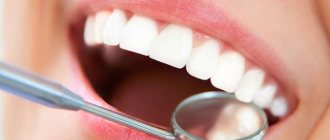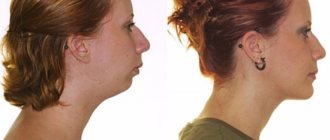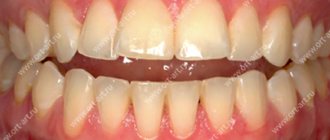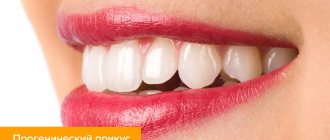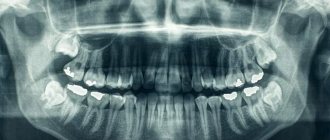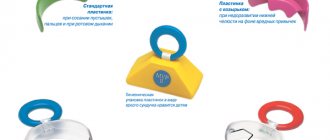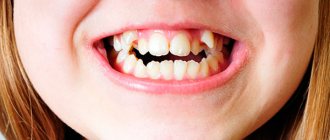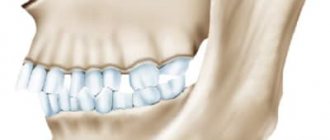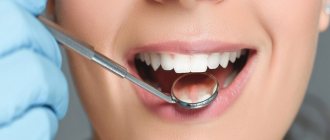Can! Braces are not the only corrective method: orthodontists have several alternative methods for straightening teeth. The easiest way to do this is if the pathology is not clearly expressed, but even in difficult cases it is possible to do without a bulky structure in the mouth.
Mild bite pathologies: plates, trainers, veneers
The easiest way to correct a bite without braces in adults is if there is minor bite pathology. In this case, there are several options.
- Trainers.
Removable silicone or plastic design that does not require custom fitting. Trainers normalize the functions of the facial muscles and align the jaws relative to each other - in some cases this is enough to bring the bite back to normal. They are worn at night and are not required to be worn during the day. - Veneers and lumineers.
A cosmetic (and therefore the fastest) way to straighten your teeth. With the help of ceramic onlays you can get rid of minor defects, for example, to close a small diastema or a crooked tooth.
Types of occlusion defects and methods of their correction
Scientists have calculated that only 40% of the planet's inhabitants are the happy owners of an ideal bite. All others have deviations from the norm to one degree or another. Defects can be critical when they have a negative impact on human health, and practically unnoticeable, not leading to moral or physical discomfort.
The picture below shows occlusion anomalies:
Modern orthodontics includes several methods for correcting malocclusion:
- using braces;
- through surgery;
- using myotherapy (physical exercises) and non-braces corrective devices.
What are aligners and how do they work?
Aligners are a completely transparent “cover” that fits over your teeth. Its shape almost completely follows the shape of the dentition, but is slightly different in order to create the pressure necessary to move the teeth. Aligners must be worn constantly, like braces, but, unlike the latter, they are almost invisible, feel much more comfortable in the mouth and can be removed by the patient independently if necessary. Every 2-3 weeks, the mouthguard needs to be replaced with a new one so that the pressure on the teeth does not weaken. Thus, a course of bite correction without braces in adults will require 20 drops.
The main feature of aligners is the absolute predictability of treatment. Before it begins, the doctor, based on the diagnostic results, creates a computer prototype of the patient’s jaw, models the trajectory of teeth movement on it and can demonstrate the final result. This approach makes it possible to clearly plan the entire process, accurately calculate how long it will take, understand how many trays will be needed and what the cost of correcting a bite in adults without braces will be.
The mouthguards are made individually for each patient using 3D printing. Each subsequent set moves the teeth a little stronger than the previous one to the ideal position. The patient can change the aligners himself after a two-week period, so it is necessary to come for a follow-up examination no more than once a month.
Hygiene when wearing aligners is simpler than when correcting a bite with braces: you don’t have to acquire a large number of devices, and it takes much less time to clean. The mouth guards are easy to clean with a simple toothbrush, and dental care is no different from usual.
What does malocclusion affect: consequences
When postponing a visit to the doctor, a person must understand the dangers of malocclusion.
This is not only an aesthetic defect that you can get used to. Due to improper positioning of teeth, internal organs and joints suffer, and health problems begin. The human jaw is the first link of the digestive system, as well as a protective barrier for the ENT organs.
So, among the main consequences of malocclusion are:
- Dental pathologies.
Atypical tooth growth leads to improper distribution of the load when chewing food, abrasion of protective enamel, and the occurrence of carious formations. Severe pathologies cause gum disease, a complication of which is tooth loss at the site of inflammation. - Indigestion.
Abnormal arrangement of teeth prevents quality chewing of food and affects the functioning of the gastrointestinal tract. - Infections and inflammations of the respiratory system.
Often, malocclusion is accompanied by incomplete closure of the lips. This provokes reflexive mouth breathing, which, in turn, leads to drying out of the mucous membranes of the nasopharynx. Dryness causes increased proliferation of bacteria and the occurrence of inflammatory processes in the upper and lower respiratory tract. - Facial asymmetry.
Hypertrophy or underdevelopment of one of the jaws causes an imbalance in the proportions of the oval of the face. A curved or, conversely, flattened profile is formed. - Diseases of the temporomandibular joint,
which provides jaw movement. The increased load on the teeth due to malocclusion also affects the functioning of the jaw joint. Without bite correction, diseases such as arthritis, ankylosis, and fibromyalgia develop, which limit the mobility of the lower jaw. - Speech therapy problems.
Abnormal position of teeth and lips interferes with the correct pronunciation of sounds. This affects auditory perception and overall literacy in reading and writing.
Some complications do not appear at a young age of the patient, but make themselves felt after 40 years, for example, joint diseases. Don't wait for unpleasant consequences. If you suspect that your teeth are growing abnormally, you should consult a specialist for diagnosis.
What types of aligners are there?
A technique for correcting malocclusion in adults without braces was invented in the late nineties in America. Since then, the technology has been replicated by other manufacturers, including Russian ones. There are now several brands of mouth guards for bite correction on the market.
- Invisalign
is a product of Align Technology, the most popular, effective and expensive aligners. In addition to the high price, they have another disadvantage: after diagnosis and drawing up a treatment plan, you have to wait a long time for the delivery of a set of mouth guards from the USA. - OrthoSnap
is another American manufacturer of aligners. It costs less, but has the same logistical problems as Invisalign. - Star Smile
is a Russian analogue of American orthodontic systems. Production is located in Russia, so the price of these aligners is lower and delivery is much faster. - 3D Smile
is another popular Russian manufacturer of aligners.
Complications
The duration and nature of complications are individual in nature and resolve spontaneously after some time:
- pain syndrome. Occurs against the background of traumatic effects on tissue/bone tissue;
- inflammation of soft tissues. Develops due to displacement and overload of bone fragments;
- divergence of seams. Requires reapplication;
- general weakness, nausea. Occurs after anesthesia;
- hyperemia/swelling. Observed immediately after the intervention, after 3-4 days the facial contours return to normal;
- constant numbness in the facial area due to nerve damage;
- speech disorders. If the dysfunction is severe, professional help may be required.
The recovery period lasts 10-14 days. It is recommended to adhere to a soft diet for the first 7-8 days: consume dairy products (yogurt, kefir, cottage cheese), eggs, boiled potatoes. In the next 14 days, it is allowed to supplement the diet with boiled meat and pasta.
After the swelling disappears, it is necessary to begin physiotherapeutic training: closing/opening the mouth, performing lateral movements.
How is a bite corrected using aligners?
Correcting a bite with aligners takes place in five stages and involves a fairly long – about a month – preparatory period.
First stage
includes an initial consultation, a thorough examination, diagnosis and, if necessary, dental treatment. Caries, pulpitis, inflammatory processes and other problems in the oral cavity are a direct contraindication to the use of aligners.
Second phase
— collection of materials for the dental laboratory: taking impressions, orthopantomogram, computed tomography.
Third stage
- laboratory. A three-dimensional model of the patient’s jaw is created on a computer, the process of teeth movement is simulated, the duration of treatment is calculated, and the required number of drops is determined. The tray set is printed on a high-precision 3D printer.
Fourth stage
- immediate start of treatment. The doctor shows the patient how to put on and remove the aligners, explains how to care for them, and applies a few drops of a special composition to the tooth enamel that improves adhesion.
Fifth stage
- the longest, includes the entire period of wearing the aligners. It can last from several months to one and a half to two years - until the desired result is achieved.
Patient Reminder
- Patients who have suffered an acute viral infection 10-14 days before the procedure are not allowed to undergo surgery. Any ailment (high blood pressure, temperature, gastrointestinal disorders, sore throat) requires rescheduling surgery;
- on the eve of hospitalization (10-12 hours) it is recommended to refrain from drinking alcoholic beverages and smoking;
- before surgery, taking liquids/food is strictly prohibited;
- You should wash off your makeup, remove dentures, jewelry, and contact lenses;
- The doctor must be aware of existing allergies to medications and routine medications taken.
The duration of the procedure depends on the volume and complexity: correction of defects on both jaws takes 4-4.5 hours, on one jaw - 1-1.5 hours, correction of the chin - 6-6.5 hours. Jaw fusion occurs in 2-4 months, wound healing in 10-14 days.
Bite correction without braces in adults: are prices affordable?
Aligners are a high-tech product that provides patient comfort and predictable results, so their price is higher than classic braces. In Moscow, prices for bite correction without braces for adults start at 150,000 rubles. The most expensive are American Invisalign aligners: their cost can reach up to 350,000 rubles, Russian developments will be cheaper. The final cost of treatment depends on the duration of wearing the trays and their number. Your doctor will be able to tell you the exact price for correcting a bite in adults without braces after a consultation. Many clinics offer payment for treatment in installments, breaking the entire amount into several payments.
Is it possible to correct a bite at 30–40 years old?
Typically, jaw position adjustments begin in childhood. Parents concerned about improper tooth growth often turn to orthodontists with the question of at what age to begin correcting the bite, and until how many years this can be done.
Correction of bite at 30 – 40 years old
Not all pathologies can be treated until permanent teeth and jaw bones are fully formed. Sometimes you have to wait until the age of 12–14, but by then the child has already gotten used to his appearance and does not pay attention to the crooked teeth. Problems appear later, when after 40 years the jaw joints begin to ache, the enamel becomes thinner, caries develops, diction deteriorates, breathing difficulties, headaches, and insomnia appear.
Therefore, even if in adolescence it was not possible to correct the bite, and this thought came to you again only at the age of 30, it is not too late to start making adjustments. And the only correct answer that a patient should hear from an orthodontist to the question at what age can a bite be corrected is that it’s never too late to start.
Yes, in adulthood the treatment is more difficult both psychologically and physiologically. But, having dealt with the problem at 25–30 years old, a person will be able to charm with his smile at 35–40.
The hardest thing is to mentally adjust to wearing braces. This therapeutic accessory is considered a teenage one. But modern devices can be almost invisible to others. And in some cases, it is possible to do without wearing braces. A qualified orthodontist will advise you on the right decision.
